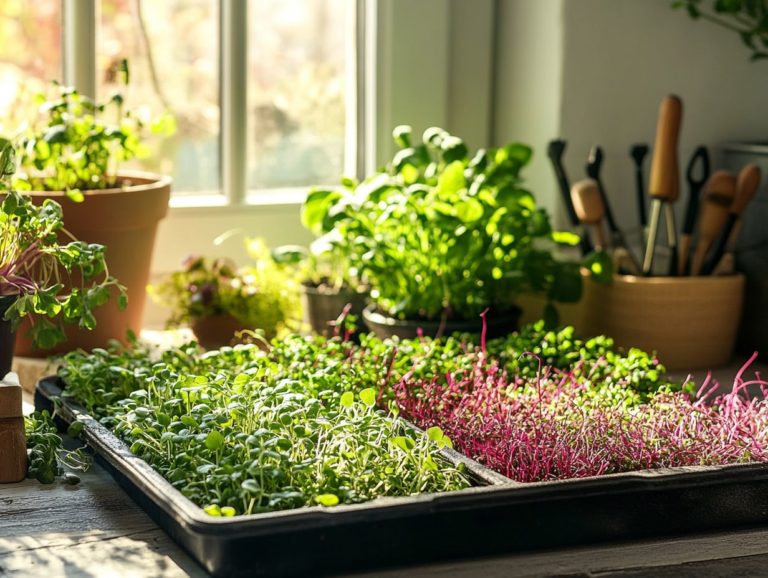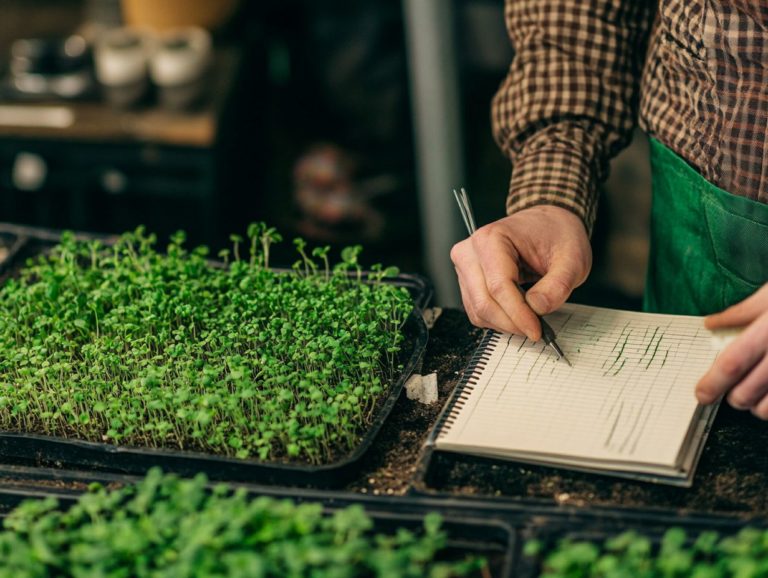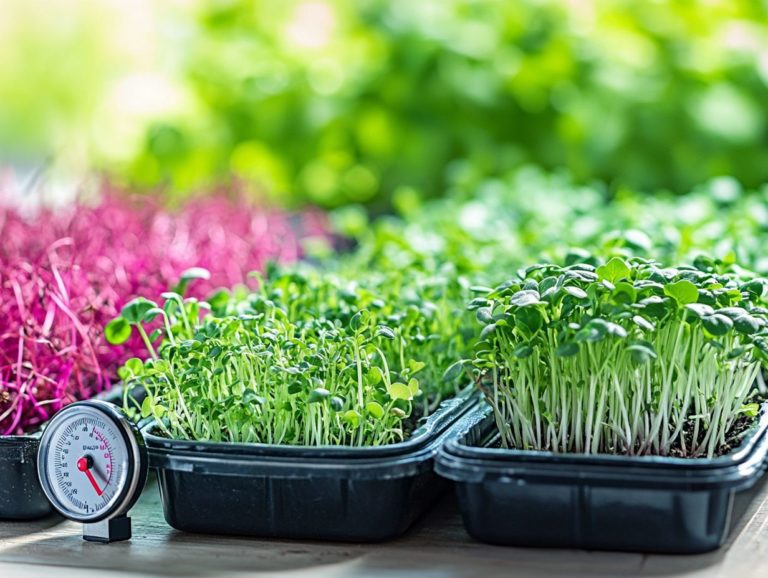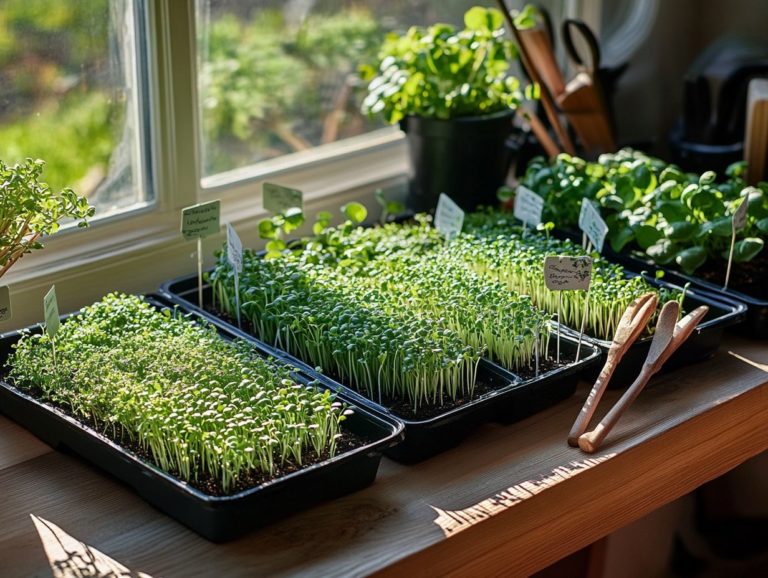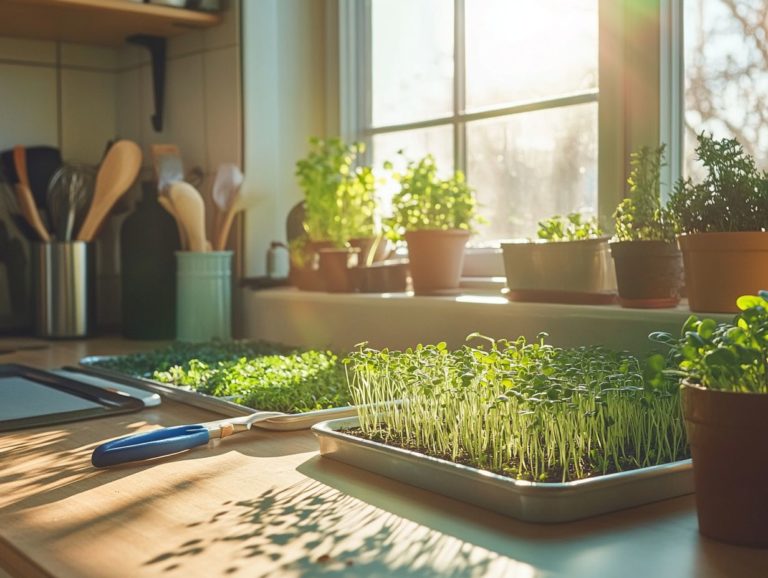Step-by-Step Guide to Sowing Microgreens
Get ready to explore the amazing world of microgreens! These delightful little plants burst with nutrients and flavor, elevating any dish they grace. They are easy to grow at home and offer incredible health benefits.
This article guides you through the nutritional value of microgreens and helps you choose the right seeds. You ll also learn about the essential materials you need for successful growth, including a comprehensive microgreens kit.
Discover a simple guide to sowing, nurturing, and harvesting these vibrant greens. Plus, get inspired with innovative recipes to incorporate them into your meals!
Contents
Key Takeaways:
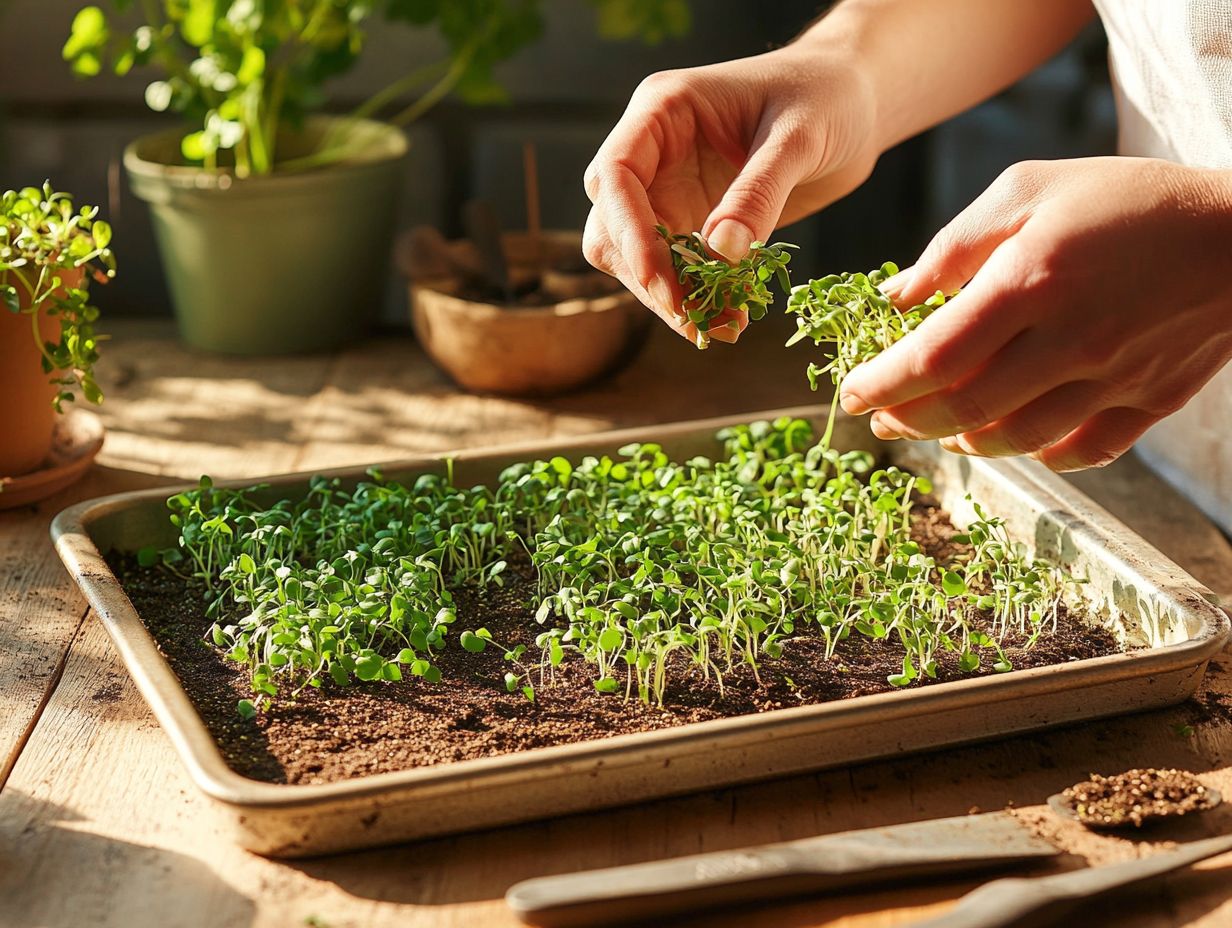
- Microgreens are young, nutrient-rich plants that are easy to grow and add a burst of flavor to meals, making them a fantastic addition to your diet.
- Choosing the right materials and seeds is essential for successfully sowing microgreens.
- Follow a step-by-step guide to properly sow, care for, and harvest microgreens, focusing on the germination process for maximum nutritional value and taste.
What are Microgreens?
Microgreens are young, edible plants that you can harvest at an early stage of growth. They re packed with health-promoting micronutrients and vibrant flavors, making them a fantastic addition to dishes like salads, Buddha bowls, and sandwiches. Often dubbed ‘vegetable confetti’, these nutrient-dense greens are easy to grow at home. They also support a balanced diet filled with essential vitamins and minerals.
Varieties like broccoli sprouts offer significant health benefits, including potential cancer-fighting properties. They are a must-have for anyone interested in indoor gardening and overall weight management.
You’ll find a wide array of options, from radish and sunflower to pea shoots, each bringing its own unique taste and texture to the table. The growing process is refreshingly straightforward, requiring minimal space and just a few supplies. This makes it perfect even for those of you who may not have extensive gardening experience, especially when growing microgreens in winter indoors.
Nutritionally speaking, microgreens can contain up to 40 times more vitamins and minerals compared to their mature counterparts, highlighting their allure in the culinary world.
Beyond their health perks, these tiny plants can infuse your meals with a burst of color and flavor, proving to be a versatile ingredient in modern cooking, enhancing both flavor and health benefits.
Benefits of Growing Microgreens
Growing microgreens opens up a world of health benefits, turning your indoor gardening into a rewarding adventure filled with nutrient-dense greens that not only burst with flavor but also brim with essential vitamins and minerals.
These vibrant plants are celebrated for their cancer-fighting properties and their role in weight management. With their impressive nutrient profile, they help fight chronic diseases, elevating both the flavor and health benefits of your meals.
Nutritional Value and Convenience
Microgreens have an impressive nutritional profile. They offer a wealth of health-promoting micronutrients, making them a great choice for indoor gardening. Growing these small plants at home means you can enjoy fresh nutrients right from your kitchen, providing an excellent source of vitamins and minerals, especially when considering nutrient value.
These vibrant greens aren t just packed with vitamins A, C, E, and K; they also boast beneficial antioxidants and phytochemicals natural compounds that can benefit health that contribute to your overall well-being. They thrive in minimal space and can flourish even under low light conditions, making them perfect for urban dwellers or anyone just starting their gardening journey.
With just a few seeds, some soil, and a splash of natural sunlight, you’ll discover a treasure trove of nutrients that transform your everyday meals into health-enhancing delights. Adding these nutrient-dense greens can elevate salads, sandwiches, and smoothies, enriching both flavor and nutritional intake in every bite while ensuring you water them daily. Don t miss out on enriching your meals!
Choosing the Right Seeds for Microgreens
Selecting the right seeds for microgreens is essential for cultivating a thriving garden. The variety you choose, including types of microgreens like arugula and kale, can greatly influence flavor, nutrient density, and growth characteristics.
You can choose seeds like arugula, radish, or kale. Learning about the different types of microgreens available, such as broccoli and basil, and knowing where to source them will elevate your indoor gardening experience.
Each variety offers distinct flavors and health benefits, including the option to enjoy cancer-fighting microgreens. It s imperative to select those that align with your culinary tastes and nutritional goals.
Types of Seeds and Where to Purchase

When it comes to growing microgreens, understanding the various types of seeds available like broccoli, basil, and mustard is crucial for achieving the flavors and health benefits you desire in your dishes, especially considering the storage of microgreens for long-lasting freshness. Whether you’re sourcing sprouting seeds from local stores or online retailers, knowing where to find quality seeds can significantly impact your indoor gardening success.
Exploring the unique flavors each microgreen offers can enhance your culinary creations. For example, cilantro adds a refreshing zest, while radish microgreens provide a delightful peppery kick. When purchasing seeds, seek out certified organic options to ensure they are free from harmful pesticides and genetically modified organisms. Also, consider their germination rates. Once you have your microgreens, check out the best methods for storing microgreens to keep them fresh and flavorful.
Checking the packaging for germination rates will guide you in selecting high-quality seeds that sprout vigorously. By grasping these essential factors, including seed density for optimal growth, you not only enhance the nutritional profile of your meals but also prepare for what to do with microgreens after harvest, paving the way for a successful and rewarding indoor gardening experience.
Materials and Equipment Needed
To effectively grow microgreens, it’s essential to have the right materials and equipment. You can opt for a comprehensive microgreens kit or gather your supplies individually, including a suitable growing medium.
Key items include:
- An appropriate growing medium
- Trays
- The right watering tools
These tools ensure successful germination and robust growth of your microgreens. By investing in high-quality equipment, including light sources for optimal sunlight exposure, you elevate your growing experience and significantly boost your chances of enjoying a plentiful harvest.
Essential Supplies for Sowing Microgreens
The essential supplies for sowing microgreens include a suitable growing medium, trays for seed placement, and tools to monitor water levels during the seed sprouting process. Proper preparation, such as soaking the seeds before planting, can greatly improve your seed sprouting rate and increase your chances of success in techniques tailored for microgreens. Remember to water daily.
In addition to these supplies, choosing the right lighting and temperature is crucial. These factors help create an ideal environment for your seedlings to thrive in low light conditions. The growing medium should be lightweight and hold water without becoming soggy, allowing for healthy root development. It’s equally important to monitor water levels; too little can cause seed dormancy, while too much may lead to mold growth.
A spray bottle can help you maintain the right humidity. By combining these practices, you ll create a thriving ecosystem that leads to a bountiful harvest and successful indoor gardening.
Step-by-Step Guide to Sowing Microgreens
A step-by-step guide to sowing microgreens offers a clear pathway to successfully growing these nutrient-rich greens. You ll start by preparing the container and soil, then care for microgreens through their different stages of development.
This simple approach ensures you ll enjoy the fresh flavors of microgreens in your cooking, leading to the ultimate reward: a beautiful harvest.
Preparing the Container and Soil
Preparing the container and soil for sowing microgreens is a vital first step that lays the groundwork for vibrant growth and rich flavor development. By selecting an appropriate growing medium and ensuring proper drainage and water retention, you set the stage for successful seed sprouting. Soaking the seeds beforehand can further enhance the sprouting process.
The choice of container is equally important in your indoor gardening journey, as it directly affects air circulation and root health. Choose vessels with drainage holes to prevent waterlogging, which can lead to mold or root rot, jeopardizing your efforts to grow microgreens. Additionally, knowing the tips for washing and storing microgreens can further enhance your gardening success.
When selecting a growing medium, consider options like peat moss, vermiculite, or a pre-mixed soil that holds water while still allowing for good drainage. By adopting these eco-friendly gardening practices, you not only create a nurturing environment for your seeds to flourish, but also enjoy faster sprouting and robust growth. Understanding the science behind microgreen growth can ultimately enhance the flavor profile of your microgreens.
Sowing the Seeds and Caring for the Microgreens
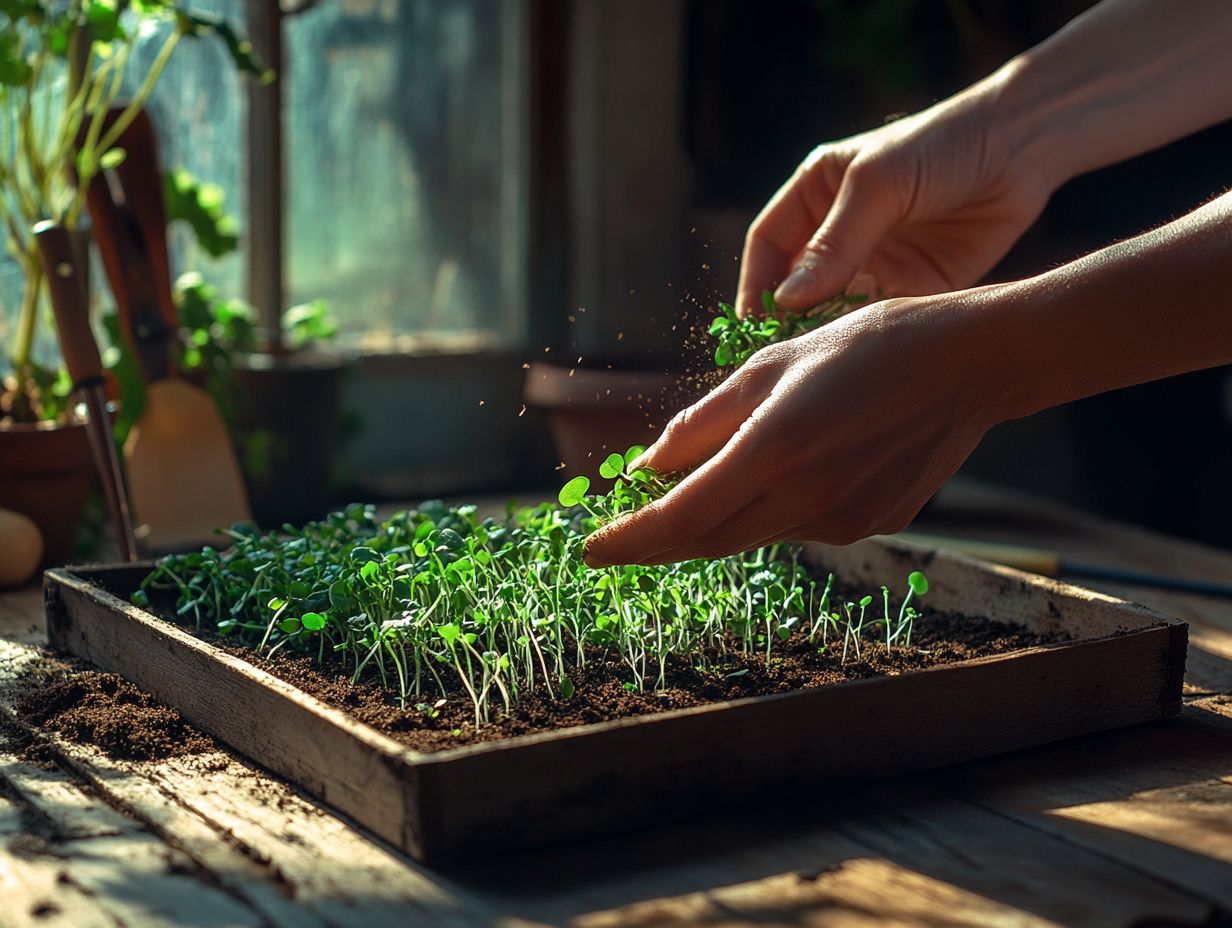
The process of sowing microgreens begins with the careful placement of seeds in prepared trays, followed by daily watering to encourage strong growth. It’s vital to provide the right amount of sunlight whether from natural sources or grow lights to nurture the seeds as they develop.
To start, selecting a well-draining soil mix is essential. Sow the seeds evenly across the surface, making sure to avoid overcrowding to allow for optimal air circulation. For those interested in continuous production, consider using techniques for growing microgreens year-round. After planting, gently mist with water to maintain consistent moisture levels without waterlogging the soil, which can cause rot.
As those tiny shoots begin to appear, establishing a daily watering routine is critical, especially since young plants are sensitive to changes in moisture. Grow your microgreens in an area that receives at least four to six hours of direct sunlight or use grow lights positioned a few inches above to promote vigorous growth and maximize nutrient content. For optimal results, consider following the perfect light conditions for microgreens, resulting in healthy, vibrant greens.
Harvesting and Using Microgreens
Harvesting and using microgreens is the exciting payoff of your indoor gardening journey, allowing you to incorporate these nutrient-packed greens into a variety of meals and culinary creations.
Knowing when to harvest microgreens gives you the best flavor and health benefits. Try different recipes to make your dishes exciting and bring a touch of adventure to your cooking.
Start your microgreens journey today for a fresh, home-grown flavor!
When and How to Harvest Microgreens
Knowing when and how to harvest microgreens is crucial for maximizing their flavor and health benefits. This varies depending on the type of microgreen. By observing their growth closely, you ll quickly learn the best time to enjoy your microgreens! Ensuring they receive daily watering will significantly contribute to their overall health.
Timing plays a pivotal role in the intensity of flavors and nutritional value, so it’s important to look for specific indicators like leaf size and color changes. For instance, many varieties are best harvested just after the first true leaves appear, as that s when their taste reaches its peak.
Using clean, sharp scissors helps you avoid damaging the plants and promotes future growth. Especially if you opt for a staggered harvest, providing proper care throughout the growing process, such as watering techniques for thriving microgreens, will help your microgreens develop robustly, ultimately enhancing their taste and vitality.
Ways to Incorporate Microgreens into Meals
Incorporating microgreens into your meals adds vibrant flavor and a wealth of health benefits, making them an exceptional choice for enhancing dishes like salads, sandwiches, and Buddha bowls. With an array of microgreen recipes at your disposal, you can creatively use these nutrient-dense greens to elevate your culinary creations while savoring their natural goodness.
These tiny greens pack a powerful punch of taste and nutrients, making them a fantastic addition to everything from an upscale dinner to a casual brunch. Imagine a sandwich layered not only with deli meats but also topped with zesty radish or peppery arugula microgreens. With using sprouting trays for microgreens, your simple lunch suddenly transforms into a gourmet experience!
For salads, blending a mix of vibrant microgreens with roasted vegetables or fruits creates a delightful contrast of textures and flavors. Their incredible health benefits, including high levels of vitamins and antioxidants, make them an essential ingredient for anyone looking to boost their nutrition in a deliciously enjoyable way. For those interested in preserving their freshness, storing microgreens effectively is key.
Frequently Asked Questions
What materials do I need to sow microgreens?
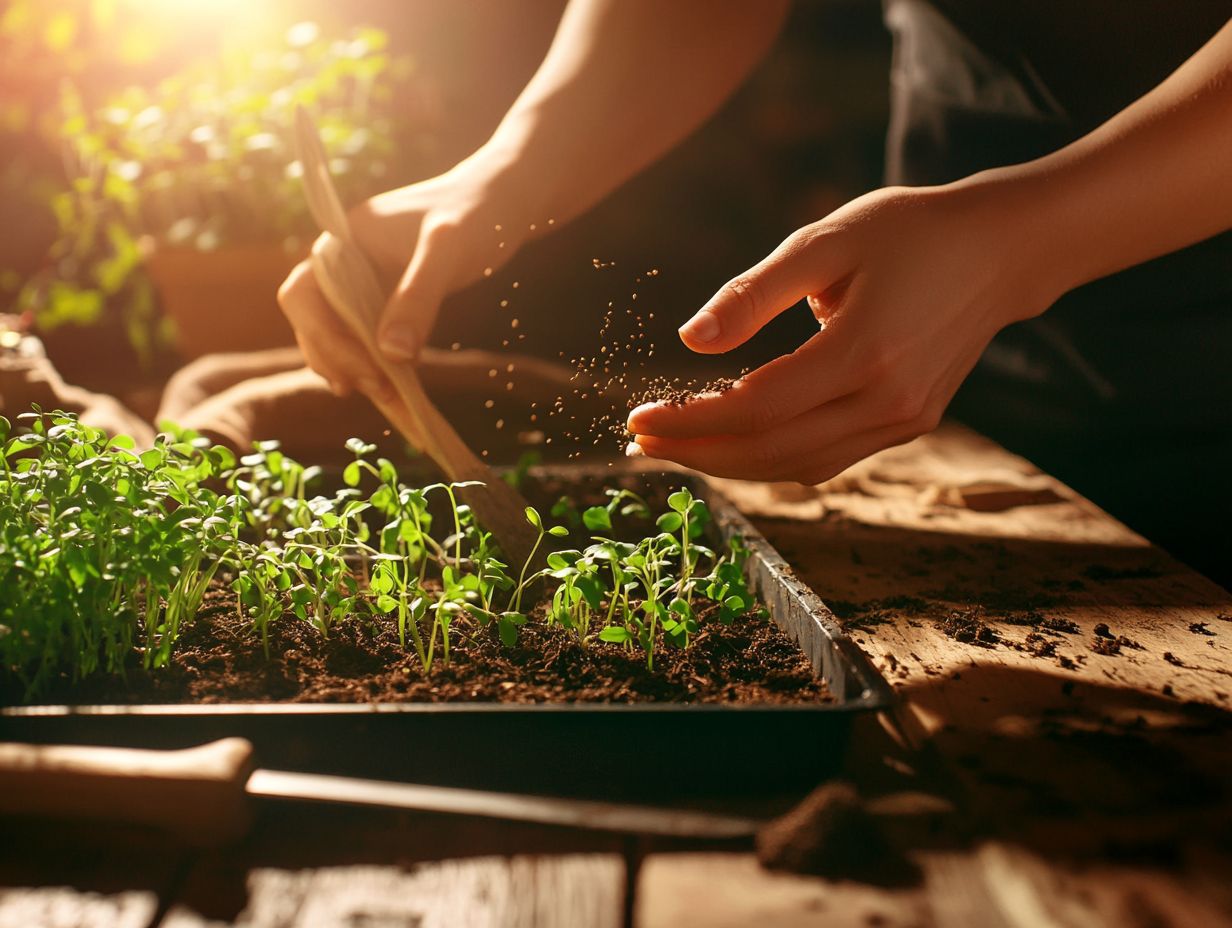
To sow microgreens, you will need potting soil, a shallow tray or container, seeds, water, and a spray bottle.
What is the best type of soil to use for sowing microgreens?
It is recommended to use potting soil for sowing microgreens, as it is lightweight and contains the necessary nutrients for the seeds to germinate.
How do I prepare the soil for sowing microgreens?
Moisten the potting soil with water before placing it in the tray or container. It should be damp but not soaking wet.
Do I need to pre-soak microgreen seeds before sowing?
It is not necessary to pre-soak microgreen seeds before sowing. However, some seeds may benefit from being soaked for a few hours prior to sowing.
How deep should I sow microgreen seeds?
The depth of sowing microgreen seeds depends on the size of the seeds. Generally, smaller seeds should be lightly sprinkled on top of the soil, while larger seeds can be gently pressed into the soil.
How often should I water my microgreens?
You should mist your microgreens with a spray bottle once or twice a day. The soil should be kept moist but not waterlogged to prevent mold growth.

